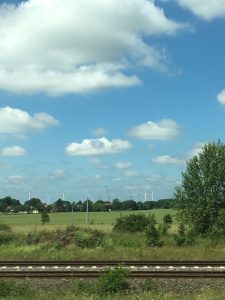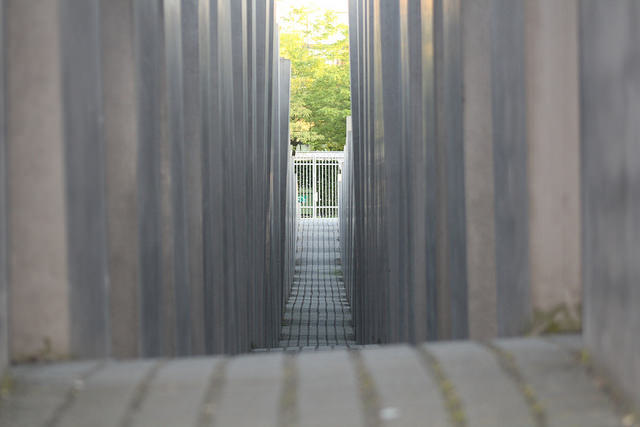It was time to say good-bye to the Netherlands. Day after day, the people we spoke to and the sites we saw convinced us that Dutch society and the built environment it inhabits have achieved a level of complex coordination that is exemplary for some of the fixes other cities and nations will require as global warming and the climate crisis continue. Now it was time to get on the train in Rotterdam and to travel across Germany, almost as far as the Polish border, to arrive at our next destination, Berlin.
It’s good to travel by train. The Dutch train system is powered completely by green energy. As of 2015, the German rail system has 42% renewables in its energy mix and is increasingly in the business of producing the renewable energy it consumes. Compared to Amtrak, travel by rail in the Netherlands and Germany is pretty inexpensive. We traveled around 700 kms for about 70 Euros per person. But what’s really wonderful about train travel is the relaxed sociability of the passenger cars, the ability to stroll through the train, to doze comfortably (and many in the group caught up on lost sleep from the hectic days and evenings in the Netherlands), and to watch the landscape transform.
We started out flat in the familiar polder landscape of the Western Netherlands. Halfway to the border, as we left the polders, we noticed the kind of natural undulations that signaled a return to land above sea level, but still primarily farmland and meadow. Crossing the German border, we noticed how dimensions increased as buildings, roads, and spaces in general were more generously sized. At the same time, tree cover expanded as we entered the network of German forests–the percentage of wooded land in Germany has remained pretty constant for two centuries. In the Netherlands, we regularly saw PV on the roofs of private homes (thank you, Marjan and Urgenda!) and companies, as well as scatterings of wind turbines–the Dutch are poised to rapidly expand both. In Germany, the incidence of wind and PV visibly increased. But the moment I love is when the group first catches a glimpse of the enormous wind and solar farms that come into view extending across the landscape. So, this is what the Energiewende looks like!
We were met at the Berliner Hauptbahnhof (main train station) by Robby of CIEE and promptly got onto the SBahn (regional rail) and then transferred to the UBahn (subway) to get out at Gneisenaustrasse in Kreuzberg, right in the middle of what was long the hippest part of West Berlin—since the Fall of the Wall, many other districts (Neukölln, Friedrichshain, Ostkreuz, Prenzlauerberg) rival Kreuzberg in hipness, but who’s going to quarrel with a quantitative increase, regardless of who’s on top? This is where the CIEE facility is to be found with its stylish and comfortable dorm rooms, lounges, café, and classrooms. Once rooms were assigned and we’d freshened up, Robby took us through a Berlin-specific orientation on cultural differences. There’s not much that isn’t tolerated in Berlin, as long as it doesn’t hurt anyone else. Equipped with our weekly transportation passes, we headed by double-decker bus to a Turkish restaurant for a welcome dinner. As many as 200,000 Turkish-Germans live in Berlin, and have for many generations.
From the restaurant, we commenced our tour of the historical district: the Brandenburg Gate, the Reichstag, a remaining stretch of the Berlin Wall, Checkpoint Charlie, the Nazi-era Ministry of Aviation (now the Ministry of Finance), the Topography of Terror Museum, and the Memorial to the Murdered Jews of Europe—all that tragic history packed into less than a square kilometer. The Memorial covers a large area and needs to be walked through in order to experience the harrowing effect of genocidal history. Each of us wandered into the Memorial in order to explore our thoughts and feelings in the spaces created by the massive concrete blocks.
That was the beginning of our intense six-day sojourn in Berlin.
Simon




